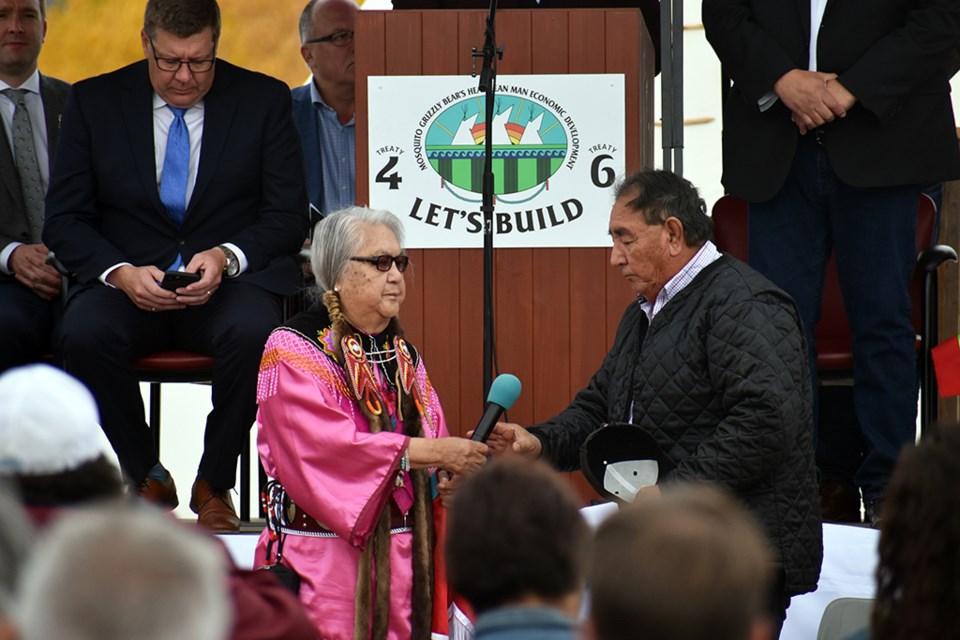THE BATTLEFORDS — History was made on Sept. 28 in the Battlefords as Mosquito Grizzly Bear's Head Lean Man began construction on the Henry Beaudry Interpretive Art and Healing Centre with FSIN Chief Bobby Cameron, Premier Scott Moe, and several other elected officials present to celebrate with a sod-turning ceremony.
Construction on the $5.8 million, 14,455 square foot facility is slated to finish in the fall of 2024 with the financial support of the Government of Canada and Saskatchewan. The centre is expected to educate, jump-start dialogue and bring together the community — all near the oldest Residential School in Canada used from 1883 to 1914.
"Today is a historic day and as a nation, Mosquito Grizzly Bear's Head Lean Man has taken great strides to ensure we protect, promote, interpret, and honour our ancestors trials of life," Chief Tanya Aguilar-Antiman Stone told the hundreds of residents who came to witness the ceremony.
"Our Nakoda story is a piece of history of the Mosquito Grizzly Bear's Head Lean Man language, culture and heritage that we now can share ... the Henry Beaudry Interpretative Art Gallery will play an important role of history in the Battlefords ... the Beaudry family is leaving a legacy and connecting us nation to nation," she added.
The Government of Canada will invest up to $4,371,287 while the Government of Saskatchewan will contribute $1,457,96 to see the project completed, as noted by speeches from Saskatchewan ministers and MLAs, and a letter from their federal counterparts. Any extra costs will fall on MGBHLM, according to a press release.
According to MGBLHM, the space will include an Indigenous land and language circle, act as a hub for learning about culture, language, and traditional knowledge and will share the history and stories of residential schools and survivors, along with MGBHLM’s history and its signing of Treaty 6 and Treaty 4.
The gallery will also showcase First Nations artists from the surrounding communities, along with the work of self-taught artist Henry Beaudry, a Second World War veteran who as a Canadian soldier helped liberate Italy and survived a prisoner-of-war camp. Beaudry is also a descendent of Chief Poundmaker.
"This is going to be around long after many of us have left this world, into heaven into the spirit world," Chief for FSIN, Bobby Cameron said, congratulating MGBHLM for the work that's been done and noting that several paintings of the late Henry Beaudry will be donated to the gallery.
"Our children are watching, 100 per cent. We live in these treaty lands, in the province of Saskatchewan together," he added, noting that two young girls — one being the MGBLHM Princess — had taken the time to respect her elders and gave them water bottles and blankets.
MGBLHM Economic Development Corp. recently undertook ground penetrating radar at the site to ensure there were no unmarked graves before moving forward with the construction as the oldest Canadian Residential school used to stand a few yards to the south. The site was formerly owned by the Oblates before MGBHLM purchased the property.
"He [Father Moe Schroeder, the last Oblate who lived at the Ridge] was very reluctant to sell this land to First Nation because he didn't believe First Nations could do it justice," Grant Beaudry, CEO for the MGBHLM Economic Development Corp., who was honoured by many speakers during the ceremony.
"I said, 'that the vision to build the Henry Beaudry Interpretative Art Gallery, [was] in the spirit of truth and reconciliation,'" he said, telling the crowd that they would be telling the story of the Battleford Industrial School, the story of his father, and the history of his own nation.
"We can't do nothing about the past but we can do something about the future. This centre will open the door to healing, dialogue ... between the government and first nations, and the churches, justice and law, all departments, all levels," he said, adding that, "...this place ... will be a place of dialogue, not debate.
"We have to work together."




